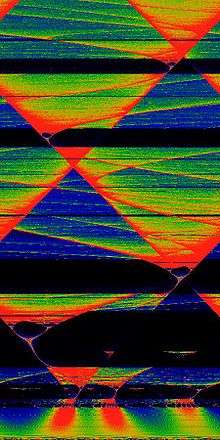Predictability
Predictability is the degree to which a correct prediction or forecast of a system's state can be made either qualitatively or quantitatively.
In statistical physics
Although the second law of thermodynamics can tell us about the equilibrium state that a system will evolve to, and steady states in dissipative systems can sometimes be predicted, there exists no genum, e.g. chaotic systems, if they do not approach an equilibrium state. Their predictability usually deteriorates with time and to quantify predictability, the rate of divergence of system trajectories in phase space can be measured (Kolmogorov–Sinai entropy, Lyapunov exponents).[1]
In mathematics
In stochastic analysis a random process is a predictable process if it is possible to know the "next" state at the present time.
In human–computer interaction
In the study of human–computer interaction, predictability is the property to forecast the consequences of a user action given the current state of the system.
In human sentence processing
Linguistic prediction is a phenomenon in psycholinguistics occurring whenever information about a word or other linguistic unit is activated before that unit is actually encountered. Evidence from eyetracking, event-related potentials, and other experimental methods indicates that in addition to integrating each subsequent word into the context formed by previously encountered words, language users may, under certain conditions, try to predict upcoming words. Predictability has been shown to affect both text and speech processing, as well as speech production. Further, predictability has been shown to have an effect on syntactic, semantic and pragmatic comprehension.
See also
References
- ↑ Boeing, G. (2016). "Visual Analysis of Nonlinear Dynamical Systems: Chaos, Fractals, Self-Similarity and the Limits of Prediction". Systems. 4 (4): 37. doi:10.3390/systems4040037.
External links
| Look up predictability in Wiktionary, the free dictionary. |

